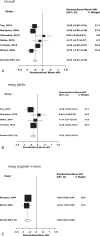The Effect of Malaria and HIV Co-Infection on Anemia: A Meta-Analysis
- PMID: 27057848
- PMCID: PMC4998764
- DOI: 10.1097/MD.0000000000003205
The Effect of Malaria and HIV Co-Infection on Anemia: A Meta-Analysis
Abstract
Malaria and human immunodeficiency virus (HIV) infections are globally important public health concerns. The objectives of this study were (i) to determine the prevalence of malaria and HIV co-infections in people living in endemic countries, and (ii) to assess the effect of co-infection on anemia.Studies were searched on electronic databases including PubMed, Embase, Medline, Google Scholar, and African Journals Online. Observational studies, assessing the prevalence of co-infection and reporting its association with anemia, were included. The methodological quality of included studies was assessed using a tool called the risk of bias assessment for non-randomized studies. Heterogeneity among studies was investigated with the I-square test. Pooled prevalence of the co-infection and its 95% confidence interval (CI) were estimated using the random-effect model, reflected on heterogeneity among studies. Summary odds ratio (OR), summary standardized mean difference (SMD), and their corresponding 95% CIs were estimated, as appropriate. Subgroup analysis and meta-regression were performed for robustness of results. Publication bias was assessed by visualization of a funnel plot.Twenty-three studies were included in the present study. Overall, the pooled prevalence of co-infection was 19% (95% CI: 15-23%, I: 98.1%), showing 26% (95% CI: 20-32%, I: 98.7%) in adults, 12% (95% CI: 7-17%, I: 95.0) in pregnant women, and 9% (95% CI: 6-11%, I: 68.6%) in children. Anemia was comparable between the monoinfected and co-infected adults (summary OR: 1.49, 95% CI: 0.93-2.37) and increased by 49% in co-infected pregnant women (summary OR: 1.49, 95% CI: 1.14-1.94). The mean hemoglobin concentration was significantly lower in the co-infected group than the monoinfected group (summary SMD: -0.47, 95% CI: -0.61 to -0.33). The results of meta-regression on the prevalence of co-infection using the publication year and total population as covariates showed the I value remained high implying a de facto random distribution of heterogeneity. An asymmetrical funnel plot indicated the presence of publication bias. Due to heterogeneity of the studies in this review, the results have to be interpreted with caution.The findings of this study suggest that the prevalence of malaria and HIV co-infection, particularly in pregnant women, requires special attention from healthcare personnel. Better understanding of the co-infection is crucial for designing treatment strategies. Future well-powered, prospective designs assessing the interaction between malaria and HIV are recommended.
Conflict of interest statement
The authors have no funding and conflicts of interest to disclose.
Figures






References
-
- Global technical strategy for malaria 2016–2030. World Health Organization [Online]. 2015 [cited 2015 Sept 12]; Available at: http://www.who.int/malaria/areas/global_technical_strategy/en/ (accessed September 12, 2015).
-
- Malaria and HIV interactions and their implications for public health policy. World Health Organization [Online]. 2004 [cited 2015 Sept 12]; Available at: http://www.who.int/hiv/pub/prev_care/malariahiv.pdf (accessed September 12, 2015).
-
- Guyatt HL, Snow RW. The epidemiology and burden of Plasmodium falciparum-related anemia among pregnant women in sub-Saharan Africa. Am J Trop Med Hyg 2001; 64 (1–2 Suppl):36–44. - PubMed
Publication types
MeSH terms
LinkOut - more resources
Full Text Sources
Other Literature Sources
Medical

